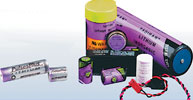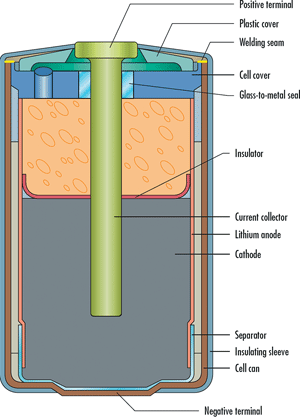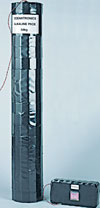

The world is going wireless. Currently, there are approximately 80 million wireless-monitoring systems in use worldwide, serving applications ranging from building automation to vibration-monitoring systems and mesh networks.
Oak Ridge National Laboratory recently outlined 12 top requirements for an ideal wireless sensor. Researchers there concluded that the number-one criterion was the need for an adequate battery life, followed by the need to be self-powered and small. This study makes clear how important battery technology is for practical wireless sensors.
Of all battery technologies currently available, lithium is considered the best choice for remote wireless sensors. Household alkaline batteries have low initial voltages and high self-discharge. In contrast, lithium chemistries feature the highest energy density (energy per unit weight and energy per unit volume) of all battery types.
To conserve power, wireless devices can be designed to remain in a sleep mode, which requires little background current (usually on the order of hundreds of microamps or less). These devices then wake up to transmit or receive data.
The power dissipation qualities of some wireless sensors are that of low power consumption in sleep mode, followed by a large spike when active. This is because they draw a high current in active mode, perhaps on the order of amps for periods ranging from a fraction of a second to a few minutes. Such behaviour is particularly true for devices transmitting signals to receivers located some distance away. One example is that of GPS-enabled buoys. Buoys may periodically read their position from GPS satellites, then report back via a burst radio transmission to a receiving station miles away. Current draw can reach several amperes for as much as a few seconds in such cases. But the delivery of these pulses presents technical challenges even to some kinds of lithium cells.
These challenges are most applicable to bobbin-type lithium cells. Such cells are particularly well suited for remote use thanks to their high capacity, small size, and an ability to withstand broad fluctuations in pressure, temperature, and shock. Bobbin cells, for example, are well suited for wireless applications fielded under the Zigbee standard. Wireless sensors following the Zigbee format can use single-chip transceiver chips that operate from under 20 mA in both transmit and receive modes.

Nevertheless, the low-rate design that gives bobbin-type lithium cells a long life impedes their ability to deliver the large currents that some kinds of remote applications demand. Contributing to this problem is a build-up of solid electrolyte interface (SEI) on the lithium anode, which is part of the internal battery. This reduction becomes even more significant when the cells are stored at elevated temperatures.
A few years ago, Tadiran developed a hybrid battery called PulsesPlus. It combines a bobbin-type cell with a patented high-rate, low-impedance HLC (hybrid layer capacitor). This hybrid system delivers extremely high currents with a generous safety margin. The HLC can supply a continuous current of up to 2 A with maximum pulses of up to 5 A.

Inside the cell
It is useful to review how lithium cells are constructed. All lithium cells use a nonaqueous electrolyte. Their nominal open-circuit voltages (OCVs) range between 2,1 and 3,9 V. Lithium cells also feature extended operating temperature ranges, with some lithium-based cells capable of operating at up to 150°C. However, lithium batteries are not all alike. Primary cells can employ a variety of lithium chemistries including: Li/CFx (lithium poly carbon monofluoride); Li/MnO2(lithium manganese dioxide); Li/SO2 (lithium sulphur dioxide); and Li/SOCl2 (lithium thionyl chloride).
Lithium thionyl chloride is the chemistry found in the bobbin-type cells often employed with wireless applications. These 3,6 V cells feature the highest energy density and voltage of all lithium chemistries, with up to 20 years of service life. Bobbin-type lithium thionyl chloride cells offer extended temperature ranges of -55 to 85°C, with some models going to 150°C. While the theoretical service life of a lithium thionyl chloride cell can exceed 20 years, the actual service life varies depending on the manufacturer.
The combination of an HLC with a bobbin cell enables the PulsesPlus to exhibit qualities of both a battery and a capacitor. Specifically, the capacitor portion of the PulsesPlus cell eliminates the voltage drop that would otherwise take place when loads draw significant pulse current. The battery portion of the cell supplies long-term, relatively low currents. Pulsed loads initially draw current from the capacitor rather than the battery. The capacitor and the battery are electrically in parallel.
An alternative to using a PulsesPlus cell would be to synthesize this behaviour by using a discrete capacitor with a separate primary cell. The problem with using conventional capacitors in such a role is that they are necessarily bulky; it takes a large capacitor to supply enough energy for time periods that can extend to minutes, as with some pulse-type loads. Moreover, the larger the capacitor, the larger the rate of charge leakage. So the capacitor is constantly discharging the cell, albeit at a low rate.
Some designs also try handling pulses through use of what are often dubbed supercapacitors in parallel with the primary cell. Supercapacitors are electrochemical capacitors. They store charge in a bulk electrolyte rather than on plates. This construction lets them be physically smaller than conventional plate-type caps. The problem with such devices is that they generally exhibit high impedance, which may limit the magnitude of the instantaneous current they can supply for a pulse. Supercapacitors are made up of individual 2,3 V units which have balancing problems when placed in series for higher voltages. Leakage current can be a problem as well.
In contrast, the HLC uses a special structure that eliminates the usual difficulties associated with supercapacitors. HLCs are made specifically to work in the 3,6 to 3,9 V nominal range and are made with only one unit.
Cell qualities
Service life mainly depends on the cell's self-discharge rate, which is governed by the chemical composition of the electrolyte, manufacturing processes, as well as mechanical and environmental considerations. Self-discharge can be made worse by high levels of impurities in the electrolyte. Extreme temperatures can also reduce battery performance, affecting both voltage and self-discharge rate.
Lithium battery performance can also be hindered by the cell's internal impedance. This internal resistance is developed by the electrolyte, the anode, and the cathode. Experienced battery manufacturers know how to effectively control impedance by blending special additives with the electrolyte. There are several other lithium chemistries that are useful as primary cells and may be candidates for specific kinds of uses. Li/CFx cells have an OCV of 3,0 V and moderate energy density. Cylindrical types use a spiral cathode for higher rate capability and have crimped plastic seals. Though generally safe, the elastomer seal can break under conditions of extremely high temperature and humidity, causing cell failure.
LiMnO2 cells are 3,0 V devices that resemble Li/CFx cells both in construction as well as performance related to high temperatures and humidity. Their energy density and voltage is slightly better than Li/CFx cells, especially at cold temperatures. Li/SO2 cells are also 3,0 V devices that deliver high current, especially at cold temperatures. Their main drawback, for wireless devices, is high self-discharge and reduced capacity. The service life and energy density of Li/SO2 cells are typically half that of lithium-thionyl-chloride cells.
For more information contact Quentin van den Bergh, Arrow Altech Distribution, +27 (0)11 923 9600, [email protected]
| Tel: | +27 11 923 9600 |
| Email: | [email protected] |
| www: | www.altronarrow.com |
| Articles: | More information and articles about Altron Arrow |

© Technews Publishing (Pty) Ltd | All Rights Reserved